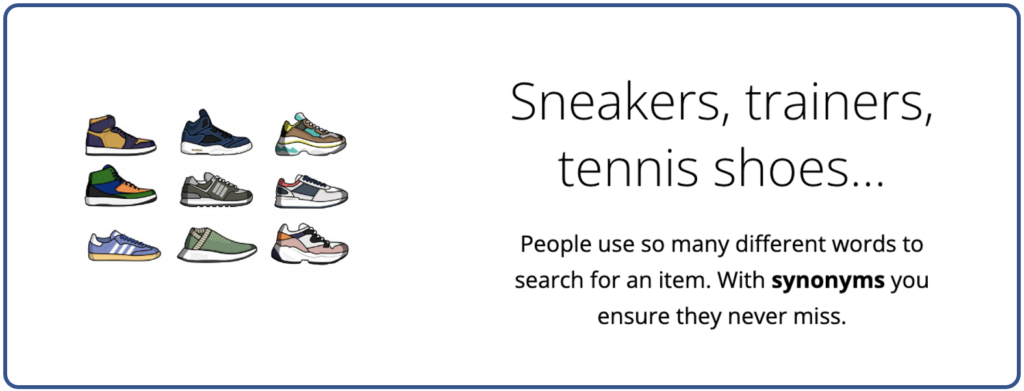How to Write Product Titles and Descriptions to Increase Internal Search Findability

You have seen this (very old) clip from Google explaining the principle of optimised site search. Although the clip was released a decade ago, it is still pretty relevant for many retailers with a basic site search. However, this blog post is not about the benefits of an optimised site search. If you’re reading this post, it means you’ve already got your site search basics set/in order. We will rather give you actionable insights to optimise your site search performance by improving your product information and attributes.
How does Site search work?
Let’s start with a quick recap of the site search basics. The search algorithm looks for the search query text and the more matches that it finds, the higher the score (and hence a higher relevance). Our advanced search features will ensure the algorithm also searches for variations of the query. For example the stem, corrected spelling, and partial matches. I won’t bore you with more details, just keep this in mind when you start implementing the do’s and don’ts explained below. BTW, if you’d like to know more on how Sooqr exactly works, read this blog on the secret sauce of Sooqr.
Let’s KISS
So how can you optimise your product text to improve findability? Remember this acronym: KISS: Keep it Short and Specific. It may sound counter-intuitive, but long text is less effective than short and specific text. The search algorithm looks at the length of the text to determine the relative importance of the keywords. When you use a long description to describe your product, if the keyword is only mentioned once or twice, it will not stand out. Reduce boilerplate text such as a generic description of the product or product family listing, because it brings down the rating. If you think it’s selevant, you can include this in a separate attribute that you include in the product datafeed (e.g. short description vs long description).
Similarly, and a frequently seen ‘mistake’, is to list information on other (related) products. This will make the key product less relevant to the search query and in many cases will cause the related products to be ranked higher. Use a separate attribute (e.g. related products) in your feed for which you can configure the search weight to be lower than the product description.
So, practically, what should you do? Make your title and description texts specific to the product, and if possible also unique to the product by using unique terms such as the serial number or the full product name. Also e.g. unique attributes, collection, combination of (unique) attributes.
An example
A visitor searches for “Nike Air Jordan”. The algorithm will search for all 3 terms and combinations of all three. To ensure that the latest Nike Air Jordans are shown first, make sure that the title includes the full 3-word term. All other Nike Air shoes or even Nike shoes will be shown at a lower position.
That doesn’t sound too hard, does it? Well, the example above is pretty simple, but when you sell 20 types of O-rings, imagine all of the variations in size and material you may have. You may be inclined to name them all“O-ring”, and have the size or material listed as separate attributes. You should certainly have separate ‘size’ and ‘material’ attributes, yet also making sure all 20 variants have a unique title. This way the correct result for a ‘Teflon 16mm O-ring’ will be shown first and the user does not have to filter separately on material or size.
Datafeed optimisation
I can hear you thinking, doesn’t Sooqr allow me to search on a combination of attributes? So why do I have to put them (also) in the title? Yes, you can certainly include any product attribute in your searchable fields, as long as you have them defined in your datefeed. But what if you have tens or even hundreds of attributes? Including them all will make your search algorithm cast a very wide net, meaning that a Teflon non-stick pan in your catalogue will be also found on par with the Teflon O-ring.
Remember KISS? This goes for product attributes as well: make them specific and unique (where possible). Also, use consistent attribute values, meaning that the colour grey is always grey and not 50 shades of grey :-). We (strongly) recommend to use the Google Merchant Feed definition for your XML datafeed. This is a widely used definition with a clear and consistent hierarchy (taxonomy) that is supported all across the industry. It will help you to structure your datafeed which will optimise the search results, and serves the Google Shopping feed as well. Oh, one more thing on attributes. Search algorithms work best with natural language, meaning real ‘human’ text. That’s what they’re designed for. So instead of using codes or acronyms for colours, sizes and features, use text (e.g. “blue”, “large”, etc.).
“Help! I see 10 versions of the same item! How do I fix this?” We get this question a lot. The answer is to use Sooqr’s grouping feature. This allows you to have all individual items in your feed, so that they are findable. Yet, grouping will only show 1 item out of the group. For grouping to work perfectly, this has to be properly defined in the datafeed. All products have a unique identifier, and grouped products will have a separate attribute that indicates they belong to a certain group of products (‘assoc ID’, or association identifier). This is defined in your CMS and will tell Sooqr what products to group. Make sure each member of the group has the same set of attributes with consistent values. So, for example, when you’re grouping on colour and size, make sure all variants have these attributes filled consistently. This will allow the algorithm to find all red dresses in size medium, and show just 1 item per group.
Pants or trousers? The optimal use of synonyms.
Everyone uses their own words to describe certain items or characteristics, and so do your visitors. Synonyms are meant to solve this ambiguity by having the algorithm search for synonyms of the words that you use throughout your text. So when you use ‘sneakers’ consistently, you can have the algorithm search for them when people type ‘trainers’, ‘sport shoes’, ‘tennis shoes’, etc. Here it’s important to say that a version of the same word is not a synonym. So plurals or singulars, or separate words instead of a single term are not synonyms. Our search algorithm will solve most of these issues for you! Synonyms are meant to account for the differencent terms that people use to find the same thing. Here are some important tips on how to use synonyms:
- Make them specific! Generic synonyms (e.g. ‘shampoo’ = ‘hair product’) will result in many more (and less relevant) search results,
- Avoid using short, 2-3 letter synonyms. In may cases this will generate too many hits and reduces the search relevance,
- Match what you’ve written in your catalogue, don’t start copying a thesaurus on the Internet. Synonyms are intended to match visitor search queries onto your catalog text.
- Circular synonyms will boost to infinity, and beyond. When ‘jeans’ matches ‘Levi’s’ and further on in your list you want to match ‘Levi’s’ to ‘straight jeans’, the algorithm will replace ‘jeans’ with ‘Levi’s’ and substitute this with ‘straight jeans’, and so on. This will cause a strong boost to items that include jeans, even if a ‘jeans jacket’ is searched for, because all variants of Levi’s straight jeans will be shown first. By the way, MySooqr warns you when a circular synonym is used, so that you are informed and can take measures to prevent it.
- On the MySooqr dashboard you will find the top Queries without results. These are the exact words people use to search for an item when they didn’t get a result. These are perfect guidance for you to create the appropriate synonyms. Just hit the plus-icon next to it to add it to synonyms. Just make sure to consider all of the above advice!

We discussed how to write your texts (KISS), how to define specific and unique product attributes, how to structure your datafeed, how to avoid flooding your search experience with variants of the same product, and gave some great tips that will improve your search conversion by using synonyms. Hope you get started with optimising your search immediately. Need some help? Just schedule a free optimization session and we’ll help you get started and even take the first steps together.
Ready to boost your eCommerce on-site conversion rate and cart value?
Start your 30-day free trial now (no string attached, and no credit card required)!


![Afbeelding voor Pop-ups: How to turn them into a conversion booster instead of a source of irritation? [Written by CCV Shop].](https://www.sooqr.com/app/uploads/2023/02/CCV-post-banner-for-website-352x248-c-default.png)

